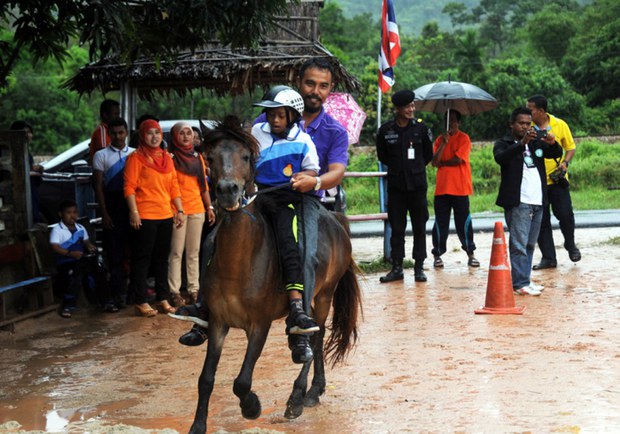Southern Thailand Couple Runs Equine Therapy Program for Autistic Kids
2016.02.10
 Johbosu Bersa demonstrates equine treatment techniques for autistic children in Cho-airong District, in southern Thailand’s Narathiwat province, Feb. 4, 2016.
Johbosu Bersa demonstrates equine treatment techniques for autistic children in Cho-airong District, in southern Thailand’s Narathiwat province, Feb. 4, 2016.
For a couple in Thailand’s Deep South, a budding interest in owning horses for recreation blossomed into an endeavor offering equine therapy to children with autism and other learning disabilities.
The husband-and-wife team Johbosu Bersa and Nisa Bersu opened the Equine Therapy Center, the first facility of its kind in Narathiwat province’s Cho-airong district.
The treatments offered there, in which autistic children are given rides on horseback, have proved so popular that the local chief district officer says he will ask the provincial governor to establish 12 centers like it across Narathiwat.
“We bought our first horse just to ride around on, just to have a little fun and get some exercise,” Johbosu, 39, told BenarNews.
“Later on, my wife was doing some research on problems faced by kids with autism. She learned that horseback riding has been used to treat kids with autism and other learning disabilities,” he said of Nisa, a state-certified nurse specializing in the care of psychiatric patients at Cho-airong Hospital
“After that, we bought three more horses, bringing our total up to four. We invited willing autistic kids in our village to take part in the treatments. Those who have taken part have shown a lot of progress,” he said.
The center was set up on about 300 square meters (3,229 square feet) of vacant land next to the couple’s home in Juap subdistrict.
When friends and neighbors noticed the couple’s efforts, they purchased three more horses. The community also drafted a request that the center be given official status as a treatment center for autistic children. The official status was granted in 2012.
When Nisa is not caring for patients at Cho-airong Hospital, she uses her free time to help her husband, who lifts children onto the horses and rides double-back with them. By word of mouth alone, news of their pioneering work has spread across the community and into parts of the neighboring Ra-ngae district.
The program serves 15 young patients, including children with varying levels of autism as well as some with unrelated learning disabilities.
According to official statistics, 565 children under the age of 18 in Narathiwat suffer from disabilities that are subdivided into nine categories. Of the total, about 10 percent fall somewhere on the autism spectrum or suffer from some other form cognitive impairment.
Treatment methods and outcome
While there is no known cure for autism, the couple said their horse-assisted therapy was having positive outcomes for many.
An example is Aming Jehteng, 8, one of three children who rode with Johbosu as part of the demonstration for officials who visited the center on Feb. 4. The boy is now in his fifth month of treatment. Aming sat in front while Mr Johbosu sat behind, hands firmly on the reins to create a sense of safety and prevent any possible falls.
It takes about six months before the positive results become apparent and it is imperative that a child’s primary caregivers play an integral role from the outset, Johbosu said after the demonstration.
While there is little medical evidence to prove that equine therapy is effective, the physical theory behind it is that the act of riding stimulates the circulatory system, improving blood supply to the brain.
“We monitor their condition after receiving the treatment and can confirm that there is a clear improvement. Many have abnormal physical conditions when they arrive here, such as problems with drooling, for example. But these improve and clear up as a result of the treatment,” Nisa told BenarNews.
“We observe their behavior from the outset and have seen that the kids who do a lot of riding have shown developmental improvements in all areas. After a year, for example, these kids can ride by themselves, without the need for someone else to control the horse,” she said.
More importantly, long-term treatment also improves social skills, Nisa added. This is crucial because autism is a developmental disorder characterized by impaired social interaction and a preference for isolation and repetitive behavior.
“But as the kids’ development improves, we begin to see them returning home and telling friends and family what they did that day, what the activity was and even the names of the other participants,” she added.
“It is a big bonus to see these kids increase their interaction with others, especially when compared to how they were before starting the treatment. This is the clearest improvement we observe over the course of the treatment.” she added.
Sangkhom left impressed.
“After learning that this treatment center has been established and is getting results, we decided to come and observe its operations with our own eyes. Having witnessed it first hand, I am of the opinion that we should send a report to the Governor asking for permission to set up similar treatment centers in all of Narathiwat’s other 12 districts,” he said.







